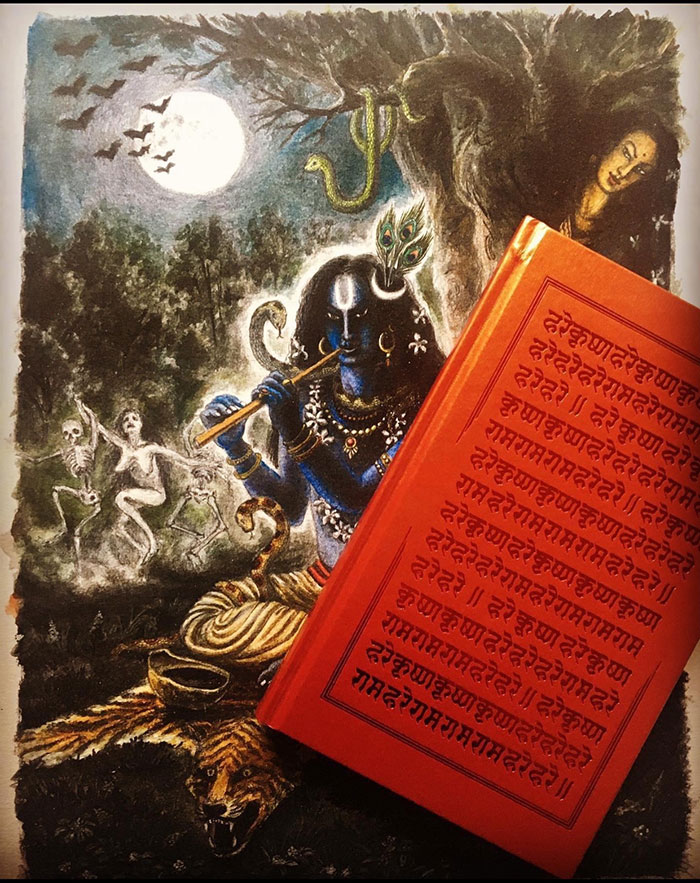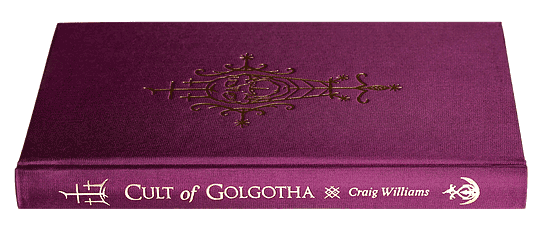![]()
Tantric Physics—New podcast interview
Cult of Golgotha



Book Information: Cult of Golgotha or purchase in paperback
Entering the Desert
by Craig Williams

The landscape of the Soul is a feral hunting ground of shadows and light, each morphing into translucent bodies of nourishment or destruction, depending upon the topographic Vision of the desert dweller. Entering the Desert explores the Terra Incognito of the Soul and reveals a primordial vision of a Pagan Sacramental Gnosticism of alchemical nature which if understood can open up the doorways to the Inner Sanctuary of Sacramental Vision.
Learn more about the book on Occult of Personality website
Anathema Publishing – Order Here

Cave of the Numinous
by Craig Williams

Book Reviews
Review/Comment by Vamadeva Shastri (David Frawley)
Craig Williams (Dharma Rakshaka) is one of the few scholars and practitioners trained in both eastern and western esoteric and healing traditions. His work encompasses Yoga, Tantra, Ayurvedic Medicine, Chinese Medicine and western esotericism – a scope that is remarkable and rare. Yet his insights are those of a dedicated practitioner, not merely an armchair academic, much less a religious devotee only. They uncover much that others have only touched at the surface.
Williams shows the connections between these eastern and western esoteric approaches. Indeed what is called Tantra in Hindu and Buddhist circles and what was called magic or alchemy in the West are kindred in many ways. As his Sanskrit name, Dharma Rakshaka, indicates his work aims to protect Dharma, referring to the universal and eternal tradition of truth that is the basis of Hinduism and the dharmic traditions coming out of India.
In India, Tibet and China, unlike Europe, occultism was never banned or regarded as irreligious. There was a recognition of the special powers and sometimes dangers of occult forces and the occult worlds, but not a dictum of faith against them. Even a text like the Yoga Sutras explores various psychic powers as part of its examination of the mind and the forces of nature. Tantra and Veda do this as well.
In India occultism, meditation and devotion were often pursued together and part of the same body of knowledge. Yet such devotion was an honoring of the Divine within, not the dictates of church or final book of revelation. Its summit was the practice of meditation towards the supreme goal of Self-realization.
In his Cave of the Numinous, Williams has produced a profound synthesis of the esoteric wisdom of India yet reflecting the deeper concerns of the modern mind and a futuristic vision that is both comprehensive and compelling. His special transformative turn of insight opens many doors of the arcane wisdom to the contemplative mind. His skill in language brings a fresh clarity into our approach to subtle domains of awareness. Williams has developed an important precise terminology and conceptual framework to convey a knowledge that goes beyond the ordinary mind and senses altogether.
True knowledge is cosmic, as he so emphatically notes. It is not simply human or psychological in nature, much less rooted in politics, economics or sociology, such as are the obsessions of modern academia. It reveals the secrets of the universe within us, not simply on the outside.
True Tantra is as he rightly states, a type of physics. It is an inner science and technology, more sophisticated, subtle and intricate than our outer science and technology. It is a cosmological approach to truth, in which one discovers the entire process of cosmogenesis happening in ones own deeper consciousness from moment to moment. It uncovers the universe within us and our own consciousness woven into the fabric of the cosmic mind. Psyche and cosmos are one as individual and universal consciousness.
Most of us are caught in a limited separative knowledge of information and data banks. A computer shows us that such knowledge is merely mechanical in nature. It only gives us snapshots of the surface of the world and its material forces. It is yet blind to the deeper energies of consciousness. We need a contact with authentic teachers, gurus and traditions as Williams notes in order to achieve a higher form of knowledge.
True Gnosis in integrative and unlimited and results in meditative insight and direct perception. This takes us to a knowledge by identity that transcends all names, forms, words and concepts. We perceive things as they are. We grasp the Self-nature of Being that is all pervasive. This takes us beyond all need to know in the ordinary sense.
Hridaya is the key concept of Upanishad thought and realization that he also highlights in an important manner. Hridaya is not merely about the heart as an organ or chakra, it is about the central point or core awareness within us. This inner cave of the heart is the ultimate origin and resort of all.
Many esoteric traditions have been criticized for their obsessions with the darkness and its powers. Williams clarifies the secret teaching behind this symbolism. Night represents the unknown or mystic night, when we let go of the outer world and learn to confront its deeper hidden currents. The dark Goddess is at once the night, the Moon, the Earth and the ground, and the endless expanse of space. Her darkness is not that of ignorance but of a secret unitary light beyond dualistic light and darkness of the mind.
Williams also places Yoga in its proper esoteric perspective, removing it from current popular distortions, through his discussion of Pratyahara. Pratyahara is the essence of Yoga, which is a process of realizing cosmic consciousness. All true Yoga is Pratyahara or an internalization of energy and awareness beyond the ordinary mind and vital force to the immortal consciousness. Without it, Yoga is only at the surface and cannot bring about deep transformation.
Pratyahara is also a simulated death. It connects to the night, the inner worlds, and immersion into the cosmic waters of the heart. It means letting go of our outer attachments and compulsions. The mystic night is also a Pratyahara or withdrawal from the superficial energies of the ego.
In his synthetic view, Williams brings in astrology as well. Saturn is the most important planet in Vedic astrology relative to karma. Any karmic reckoning in life requires an encounter with Saturn's energy. If we learn to do this consciously we can work through and transcend karma.
Williams adds special insights, meditative ideas, and specific rituals to aid the reader in the absorption and application of this profound knowledge.
It is important that such teachings as those of Craig Williams reach a broader audience. The Yoga and healing world remains largely at the surface and a physical affair. Williams shows the way to the deeper Yoga of pure consciousness, and the deeper healing of the spiritual heart, which is the return to our immortal Self that has no need of either body or mind.
Williams shows how we can extract the essence of the greater esoteric traditions today and recognize their global roots, including a central homeland or main region of preservation in the Himalayas. He is not only Dharma Rakshaka or the protector of Dharma, but a Dharmacharya, a teacher or acharya of Dharma.
Today we are entering into a new planetary age in which we can understand how older esoteric traditions can link us with the cosmic mind and the subtle energies now being discovered by modern physics. William's insights take us very far in this direction of individual and planetary integration.
Book Review and Interview with Author Craig Williams by Maya Grey
I first met Craig Williams at the annual Esoteric Book Conference in Seattle several years ago where he was giving a presentation about art and different aspects of the Dark Goddesses in Hindu mythology. I was immediately impressed by, not only his occult knowledge, but with the depth and breath of his topic. My attention was grabbed as he spoke about how the seeker must work hard in their own learning and healing...
Real Left-Hand Tantra: A Review of Cave of The Numinous by People of Shambhala
More than a book, the Cave of the Numinous by Craig Williams (Yogacharya Dharma Rakshaka) is a companion for the journey of initiation into esoteric Hinduism.
At 159 pages, it is a concise though challenging work, intended for the dedicated initiate of Left-hand Tantra, as well as other Gnostic and esoteric currents that might articulate the Mysteries through comparable symbols and teachings. It is a work that should be read slowly, methodically, and, undoubtedly, more than once or twice...
